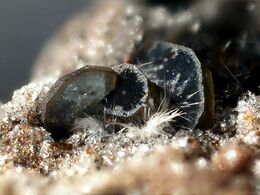Mullite
Topic: Chemistry
 From HandWiki - Reading time: 3 min
From HandWiki - Reading time: 3 min
| Mullite | |
|---|---|
 White, filamentous mullite in front of thicker osumilite platelets (Photo width 1.5 mm) Found in Wannenköpfe, Ochtendung, Eifel, Germany | |
| General | |
| Category | Nesosilicate |
| Formula (repeating unit) | Al6Si2O13 |
| Strunz classification | 9.AF.20 |
| Crystal system | Orthorhombic |
| Crystal class | Dipyramidal (mmm) H-M symbol: (2/m 2/m 2/m) |
| Space group | Pbnm, Pnnm |
| Unit cell | a = 7.5785(6) Å, b = 7.6817(7) Å, c = 2.8864(3) Å; Z = 1 |
| Identification | |
| Color | Colorless to pale pink or grey |
| Crystal habit | Prismatic to acicular crystals |
| Cleavage | Good on [010] |
| Optical properties | Biaxial (+) |
| Refractive index | nα = 1.642 - 1.653 nβ = 1.644 - 1.655 nγ = 1.654 - 1.679 |
| Birefringence | δ = 0.012 - 0.026 |
| 2V angle | Measured: 20° to 50° |
| References | [1][2][3][4] |
Mullite or porcelainite[6] is a rare silicate mineral formed during contact metamorphism of clay minerals. It can form two stoichiometric forms: 3Al2O32SiO2 or 2Al2O3 SiO2. Unusually, mullite has no charge-balancing cations present. As a result, there are three different aluminium sites: two distorted tetrahedral and one octahedral.
Mullite was first described in 1924 for an occurrence on the Isle of Mull, Scotland.[4] It occurs as argillaceous inclusions in volcanic rocks in the Isle of Mull, inclusions in sillimanite within a tonalite at Val Sissone, Italy and with emerylike rocks in Argyllshire, Scotland.[2]
Porcellanite
Mullite (porcelainite) can be found as a constituent mineral in a type of thermally-metamorphosed rock called porcellanite.[7]
Use in porcelain
Mullite is present in the form of needles in porcelain.[8]
It is produced during various melting and firing processes, and is used as a refractory material,[9] because of its high melting point of 1840 °C.[10]
In 2006 researchers at University College London and Cardiff University discovered that potters in the Hesse region of Germany since the late Middle Ages had used mullite in the manufacture of a type of crucible (known as Hessian crucibles), that were renowned for enabling alchemists to heat their crucibles to very high temperatures.[11][12]
The formula for making it (using kaolinitic clay and then firing it at temperatures above 1100 °C) was kept a closely guarded secret.[citation needed]
Mullite morphology is also important for its application. In this case, there are two common morphologies for mullite. One is a platelet shape with low aspect ratio and the second is a needle shape with high aspect ratio. If the needle shape mullite can form in a ceramic body during sintering, it has an effect on both the mechanical and physical properties by increasing the mechanical strength and thermal shock resistance. The most important condition relates to ceramic chemical composition. If the silica and alumina ratio with low basic materials such as sodium and calcium is adjusted, the needle shape mullite forms at about 1400 °C and the needles will interlock. This mechanical interlocking contributes to the high mechanical strength of porcelain.[13][14]
Use as a catalyst
Recent research indicates that a synthetic analogue of mullite can be an effective replacement for platinum in diesel engines for exhaust management.[15]
Notes
- ↑ Mineralienatlas
- ↑ 2.0 2.1 http://rruff.geo.arizona.edu/doclib/hom/mullite.pdf Handbook of Mineralogy
- ↑ http://www.mindat.org/min-2806.html Mindat
- ↑ 4.0 4.1 http://webmineral.com/data/Mullite.shtml Webmineral
- ↑ Warr, L.N. (2021). "IMA–CNMNC approved mineral symbols". Mineralogical Magazine 85 (3): 291–320. doi:10.1180/mgm.2021.43. Bibcode: 2021MinM...85..291W. https://www.cambridge.org/core/journals/mineralogical-magazine/article/imacnmnc-approved-mineral-symbols/62311F45ED37831D78603C6E6B25EE0A.
- ↑ Neuendorf, K.K.E., ed (2005). Glossary of Geology (5th ed.). Alexandria, Virginia: American Geological Institute. p. 428. ISBN 978-0922152896.
- ↑ Fediuk, F.; Langrova, A.; Melka, K. (2003). "North Bohemian Porcellanites and their Mineral Composition: the Case of the Dobrčice Quarry, the Most Basin". Geolines 15: 35–43. http://geolines.gli.cas.cz/fileadmin/volumes/volume15/G15-035.pdf.
- ↑ Kingery, W.D., ed (1960). Ceramic Fabrication Processes. New York City: John Wiley & Sons.
- ↑ H. Schneider & S. Komarneni (2005) Mullite. Wiley, VCH, 509 pp, ISBN:3-527-30974-8
- ↑ Kyanite Mining Corporation (2009-10-25). "Virginia Mullite". http://www.kyanite.com/mullite.html.
- ↑ University College London (2006-11-23). "21st Century Technology Cracks Alchemists' Secret Recipe". Science Daily. ScienceDaily LLC. https://www.sciencedaily.com/releases/2006/11/061123120134.htm. Retrieved 2008-01-12.
- ↑ Martinon-Torres M.; Freestone I.C.; Hunt, A.; Rehren, T. (2005). "Mass-produced mullite crucibles in medieval Europe: Manufacture and material properties". Journal of the American Ceramic Society 91 (6): 2071–2074. doi:10.1111/j.1551-2916.2008.02383.x.
- ↑ Hanson, Tony. "Mullite". digitalfire.com. https://digitalfire.com/material/mullite.
- ↑ "Vitrification Behaviour of The Porcelain Tile". Ceramics Research Co.. 2012. https://www.ceramic-research.com/articles_01.html.
- ↑ Wang, W.; G. McCool; N. Kapur; G. Yuan; B. Shan; M. Nguyen; U. M. Graham; B. H. Davis et al. (17 August 2012). "Mixed-Phase Oxide Catalyst Based on Mn-Mullite (Sm, Gd)Mn2O5 for NO Oxidation in Diesel Exhaust". Science 337 (6096): 832–835. doi:10.1126/science.1225091. PMID 22904009. Bibcode: 2012Sci...337..832W. https://www.science.org/doi/full/10.1126/science.1225091. Retrieved 2012-08-16.
- Martinón-Torres, Marcos; Thilo Rehren; Ian C. Freestone (November 2006). "Mullite and the mystery of Hessian wares" (PDF online reproduction). Nature (London: Nature Publishing Group) 444 (7718): 437–438. doi:10.1038/444437a. PMID 17122847. Bibcode: 2006Natur.444..437M. http://www.ucl.ac.uk/archaeology/staff/profiles/martinon/Martinon-Torres%20et%20al%202006%20Nature.pdf.
- Schneider, Hartmut (2005). "General Introduction". in Hartmut Schneider. Mullite. Weinheim, Germany: Wiley-VCH. pp. xv–xx. ISBN 978-3-527-30974-0. OCLC 58051400.
- "Sithean Sluaigh, Strathclyde, Scotland, UK". MinDat. http://www.mindat.org/loc-5100.html. Retrieved 6 November 2015.
 |
 KSF
KSF